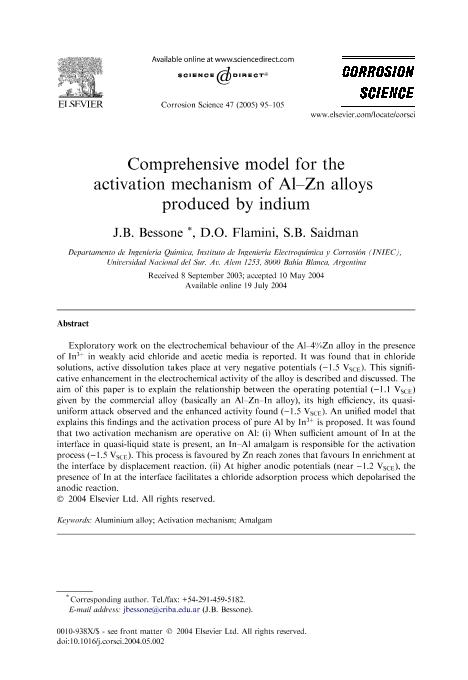Mostrar el registro sencillo del ítem
dc.contributor.author
Bessone, Jorge Bartolome

dc.contributor.author
Flamini, Daniel Omar

dc.contributor.author
Saidman, Silvana Beatriz

dc.date.available
2020-02-17T21:31:12Z
dc.date.issued
2005-01
dc.identifier.citation
Bessone, Jorge Bartolome; Flamini, Daniel Omar; Saidman, Silvana Beatriz; Comprehensive model for the activation mechanism of Al-Zn alloys produced by indium; Pergamon-Elsevier Science Ltd; Corrosion Science; 47; 1; 1-2005; 95-105
dc.identifier.issn
0010-938X
dc.identifier.uri
http://hdl.handle.net/11336/97849
dc.description.abstract
Exploratory work on the electrochemical behaviour of the Al-4%Zn alloy in the presence of In3+ in weakly acid chloride and acetic media is reported. It was found that in chloride solutions, active dissolution takes place at very negative potentials (-1.5 VSCE). This significative enhancement in the electrochemical activity of the alloy is described and discussed. The aim of this paper is to explain the relationship between the operating potential (-1.1 VSCE) given by the commercial alloy (basically an Al-Zn-In alloy), its high efficiency, its quasi-uniform attack observed and the enhanced activity found (-1.5 VSCE). An unified model that explains this findings and the activation process of pure Al: by In3+ is proposed. It was found that two activation mechanism are operative on Al: (i) When sufficient amount of In at the interface in quasi-liquid state is present, an In-Al amalgam is responsible for the activation process (-1.5 VSCE). This process is favoured by Zn reach zones that favours In enrichment at the interface by displacement reaction, (ii) At higher anodic potentials (near -1.2 VSCE), the presence of In at the interface facilitates a chloride adsorption process which depolarised the anodic reaction.
dc.format
application/pdf
dc.language.iso
eng
dc.publisher
Pergamon-Elsevier Science Ltd

dc.rights
info:eu-repo/semantics/openAccess
dc.rights.uri
https://creativecommons.org/licenses/by-nc-sa/2.5/ar/
dc.subject
ACTIVATION MECHANISM
dc.subject
ALUMINIUM ALLOY
dc.subject
AMALGAM
dc.subject.classification
Físico-Química, Ciencia de los Polímeros, Electroquímica

dc.subject.classification
Ciencias Químicas

dc.subject.classification
CIENCIAS NATURALES Y EXACTAS

dc.title
Comprehensive model for the activation mechanism of Al-Zn alloys produced by indium
dc.type
info:eu-repo/semantics/article
dc.type
info:ar-repo/semantics/artículo
dc.type
info:eu-repo/semantics/publishedVersion
dc.date.updated
2020-02-13T14:06:08Z
dc.journal.volume
47
dc.journal.number
1
dc.journal.pagination
95-105
dc.journal.pais
Estados Unidos

dc.journal.ciudad
Nueva York
dc.description.fil
Fil: Bessone, Jorge Bartolome. Consejo Nacional de Investigaciones Científicas y Técnicas. Centro Científico Tecnológico Conicet - Bahía Blanca; Argentina. Universidad Nacional del Sur. Departamento de Ingeiería Química; Argentina
dc.description.fil
Fil: Flamini, Daniel Omar. Consejo Nacional de Investigaciones Científicas y Técnicas. Centro Científico Tecnológico Conicet - Bahía Blanca; Argentina. Universidad Nacional del Sur. Departamento de Ingeiería Química; Argentina
dc.description.fil
Fil: Saidman, Silvana Beatriz. Universidad Nacional del Sur. Departamento de Ingeiería Química; Argentina. Consejo Nacional de Investigaciones Científicas y Técnicas. Centro Científico Tecnológico Conicet - Bahía Blanca; Argentina
dc.journal.title
Corrosion Science

dc.relation.alternativeid
info:eu-repo/semantics/altIdentifier/url/https://www.sciencedirect.com/science/article/pii/S0010938X04001209
dc.relation.alternativeid
info:eu-repo/semantics/altIdentifier/doi/http://dx.doi.org/10.1016/j.corsci.2004.05.002
Archivos asociados
